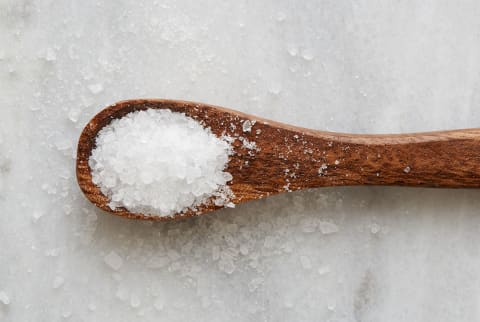Advertisement
There Are So Many Types Of Salt — Here's An RD's Advice On Picking One


Who would've thought something as seemingly simple as salt could be so, well, complicated? With so many types available to buy, we wanted to get to the bottom of the question: How do we know which one to buy?
Change the way you think about salt
If you think about salt as something you just need one variety of, this is your sign to change your tune: One of the benefits of there being so many types is that you can use them for different applications.
"I tend to recommend people think about what they will be using that salt for," Jessica Cording, M.S., R.D., CDN, tells mindbodygreen. She says, "I generally like regular sea salt as an all-purpose," but for finishing salt, "I use the Maldon flaky sea salt, but if you want something coarser, kosher salt is nice."
If you want to add even more to the salt roster, there's more to be found in the spice aisle: "Specialty salts can be a nice way to add a little pop of flavor or a little texture when added as a garnish at the end of cooking," says Cording.
But what about nutrients?
When it comes to salt, the nutrient that probably comes to mind first is obviously sodium—but quick on its heels is probably questions about iodine: Should we be worried about buying salts that aren't iodized?
"The primary nutrient we should aim to get from salt is sodium," says Cording. "It's a mineral and an electrolyte and plays an important role in supporting fluid balance in the body (hence, why there is a sweet spot and too much or too little can be problematic). It also plays a role in nerve and muscle function."
"You do want to be mindful to use a light touch, as salt does contain a lot of sodium, and it's recommended that healthy adults cap their daily intake around 2,300 mg (of sodium per day)," she further explains. "I also tell people not to stress about the fact that sea salt isn't iodized. Iodine is present in a wide variety of foods, such as fish, seaweed, and sea vegetables and eggs."
And really, you shouldn't be looking to salt as a source of nutrients (other than that base-level sodium intake): "While sea salt is often highlighted for its mineral content, I usually tell my patients to get those nutrients from other foods they're present in rather than relying on salt," Cording explains. "To meet those needs, you'd end up having to eat a lot of salt, which would come with its own adverse effects."
Why do we think of salt as a, well, bad thing?
"Salt gets a bad rap because of the association between high levels of sodium intake and cardiovascular disease risk," explains mbg's former director of scientific affairs and registered dietitian Ashley Jordan Ferira, Ph.D., RDN. "But because of that link, people sometimes forget, sodium is still absolutely essential on a daily basis. It's one of the top two essential electrolytes."
"There are fewer opportunities than you might think to consume natural sources of sodium in the diet," continues Ferira, "but sadly, lots of Americans are consuming excessive amounts of processed foods (with loads of added sodium), so it's not a nutrient of concern for most. Actually, if you eat super clean and emphasize fruit, vegetables, and legumes, it's certainly possible to not consume enough sodium."
Outside of salt, "The ocean is the top source of iodine," she says, echoing Cording's point. "Top food sources of iodine include fish, seaweed, shrimp, and seafood in general, dairy products, and iodized salt."
The takeaway
Essentially, it's time to stop thinking about salt as a one-size-fits-all situation: Having a few options in your pantry to fit different uses can help make your cooking more exciting. Personally, I've started keeping coarse sea salt, Maldon, and occasionally a few specialty salts on hand to use at different points in cooking.
And instead of stressing about optimizing your salt choice for nutrients, just make sure you're not overdoing it on sodium—and then look for the other vitamins and nutrients like iodine from other foods.
